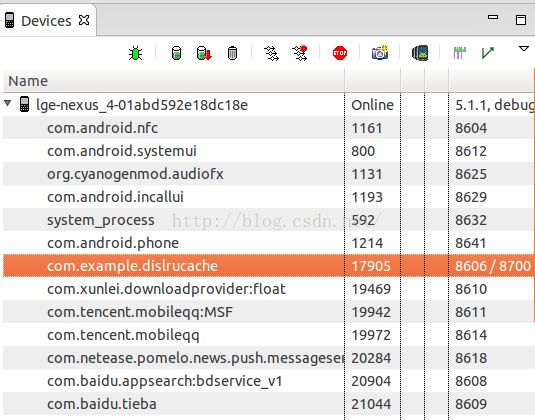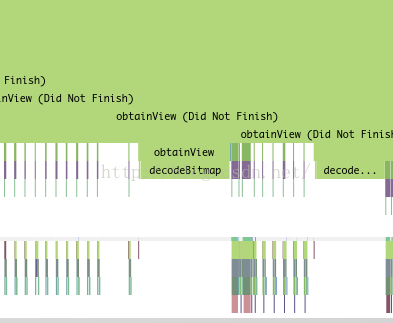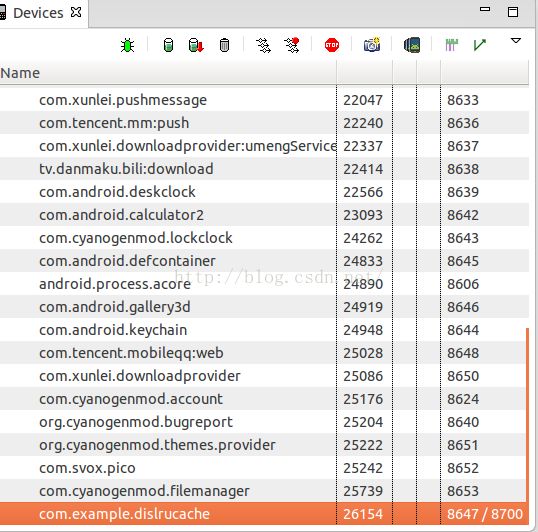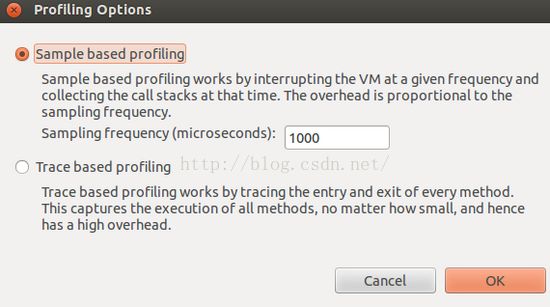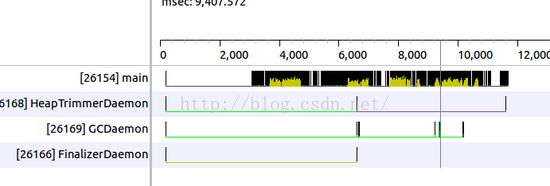- Android性能实战——Systrace分析实例(十二)
c小旭
Android性能优化android性能优化
上一篇文章我们得到了一个html文件,这里我们来通过拿到的trace.html文件来分析一些耗时场景。一、简单场景分析1、快捷键使用在开始分析案例之前我们先来看一下快捷键的使用,可以加快查看Systrace的速度,下面是一些常用的快捷键。W:放大Systrace,放大可以更好地看清局部细节S:缩小Systrace,缩小以查看整体A:左移D:右移M:高亮选中当前鼠标点击的段(可以快速标识出这个方法的
- Android性能优化(Memory)
weixin_33901641
uishell操作系统
性能相关:UI卡顿/ANR/内存泄漏——>OOM内存泄漏的本质:较长生命周期对象持有较短生命周期的引用导致,较短引用没法释放内存。GcRoots:GarbageCollector的对象,收集非GCRoots的引用对象,通常的GCRoot有哪些?www.jianshu.com/p/dcfe84c50…通过SystemClassLoader或者BootClassLoader加载的class对象,通过自
- android-性能分析
以下是Android性能分析的完整指南,涵盖核心工具、优化方向及实操方法,适用于2025年开发环境:⚙️一、性能分析工具分类1.官方工具链工具用途关键能力版本适配AndroidProfiler实时监测CPU/内存/网络/能耗火焰图分析、内存泄漏检测(支持Activity/Fragment自动检测)AndroidStudio3.6+Perfetto系统级追踪(替代Systrace)线程调度、GPU渲
- Android性能优化-检测App卡顿
augfun
简书转载
在移动APP性能评测-流畅度评测中,我们介绍了如何准确客观评价APP的流畅度,最终采用SM指标来评价应用的流畅度,在知道如何评价流畅度之后,我们应该如何来检测出APP中的UI卡顿就是我们面临的一个新的问题;在Android性能优化-App卡顿中介绍了Google官方提供的检测卡顿的方法,除此之外还有那边比较好的方法来检测应用卡顿?目前主流的方法主要有:1.利用UI线程Looper打印的日志,典型代
- Android性能分析之emmc坏块测试
Ian22l
1.android支持emmc坏块测试工具代码路径:./external/e2fsprogs/misc/badblocks.cAndroid.bp编译方式:./external/e2fsprogs/misc/Android.bp//########################################################################//Buildbadbl
- 深度拆解!Android BlockCanary 系统交互与线程调度监测(3)
Android 小码蜂
AndroidLeakCanary框架详解androidflutterkotlinandroid-studioandroidjetpack
深度拆解!AndroidBlockCanary系统交互与线程调度监测的底层奥秘一、引言在Android应用开发领域,应用的流畅度直接影响用户体验。卡顿现象不仅会降低用户对应用的好感度,甚至可能导致用户流失。BlockCanary作为一款高效的Android性能监测工具,能够精准捕捉应用卡顿问题。而其强大功能的核心,离不开与Android系统的深度交互以及对线程调度的实时监测。本文将从源码层面深入剖
- 取经之路 - Android性能优化
空腹吃早饭伤胃
文章目录Android性能-绘制Android性能-启动Android性能-布局Android性能-内存Android性能-卡顿Android性能-异步Android性能-瘦身Android性能-电量Android性能-网络Android性能-无响应Android性能-BitmapAndroid性能-绘制Android系统16毫秒发出一个信号,触发UI进行渲染view的绘制保持在60帧每秒,绘制时
- Android性能优化分析之一:全网最全性能优化系统思维导图SOP
一起搞IT吧
Android性能优化专题android性能优化
【关注我,后续持续新增专题博文,谢谢!!!】上一篇我们讲了:hwasan/asan详细分析踩内存之十:总结这一篇我们开始讲:Android性能优化分析之一:性能优化系统思维导图SOPSOP构思初步计划:PS:构思完整后,再编写博文发布,欢迎大家关注并给出意见,以便整理完整。谢谢。对于APP而言,从APP启动开始:(部分)APP安装优化:pkms/apk原理包大小优化APP启动优化冷,热,温启动优化
- Android系统性能监控最全面分析与实践(一)_android性能监控
2501_91510632
httpudphttpswebsocket网络安全网络协议tcp/ip
随着移动互联网技术的发展,安卓APP的功能越来越多,对于APP性能的要求也随之提高。目前有很多应用性能监控(APM:Applicationperformancemonitor)的工具,如阿里的mobileperf,网易开源的Emmagee,腾讯的Matrix等。对于开发者而言,Keymob克魔开发助手也是一个不错的选择,它提供了全面的性能监控解决方案,能够帮助开发者更好地优化应用性能。以上主流的性
- Android性能优化第(八)篇---App启动速度优化之耗时检测处理
very_on
performence
应用的启动速度缓慢这是很多开发者都遇到的一个问题,比如启动缓慢导致的黑屏,白屏问题,大部分的答案都是做一个透明的主题,或者是做一个Splash界面,但是这并没有从根本上解决这个问题。那么如何从根本上解决这个问题或者做到一定程度的缓解?一、应用的启动方式1、冷启动:当启动应用时,后台没有该应用的进程,这时系统会首先会创建一个新的进程分配给该应用,这种启动方式就是冷启动。2、热启动:当启动应用时,后台
- 推荐一款强大的Android性能监控工具: PerfMon+
史跃骏Erika
推荐一款强大的Android性能监控工具:PerfMon+项目地址:https://gitcode.com/gh_mirrors/pe/PerfMon-Plus在当今快速发展的移动应用领域中,对应用程序的性能进行实时监测和优化变得日益重要。为此,我们向大家特别推荐一款功能强大且易用的Android性能监控工具——PerfMon+。一、项目介绍**PerfMon+**是一款专为Android设备设计
- 秒开WebView Android性能优化全攻略:深度解析与实战策略
俊星学长
android性能优化
秒开WebViewAndroid性能优化全攻略:深度解析与实战策略在Android开发中,WebView作为一个重要的组件,用于在应用中嵌入和展示网页内容。然而,WebView的性能往往成为影响用户体验的关键因素之一。实现WebView的“秒开”体验,不仅需要开发者对WebView的工作机制有深入的理解,还需要掌握一系列性能优化策略。本文将从多个维度深入探讨AndroidWebView的性能优化,
- Android性能测试总结
软件测试android
1.性能测试目的优化应用程序,提高用户使用体验2.性能测试指标CPU主要关注CPU使用率,CPU使用率过高会导致ANR、Crash、设备发热等问题长时间情况下,CPU占有率应≤85%GPU主要关注GPU是否过度绘制,通常有如下情况:一个像素点绘制了多次,过度绘制会影响动画性能,使其不流畅主线程中执行了太多任务,UI渲染跟不上Sync信号而导致掉帧、卡顿App响应时间常见指标如下:优秀:0~0.4s
- Android性能优化之启动速度优化
Just_Paranoid
Androidandroid性能优化ProfilerSystrace
Android性能优化之启动速度优化1.App启动流程2.测试启动耗时的方法3.测试启动耗时的分析工具3.1AndroidProfiler3.2TraceView3.3Systrace4.如何优化启动时间4.1.减少DEX文件大小4.2优化Application初始化4.3优化Activity加载4.4使用启动引导页4.5使用启动优化库5.代码分析示例启动速度是衡量Android应用性能的重要指标
- Android 性能优化实战:打造流畅体验
斯陀含
android性能优化
Android性能优化实战:打造流畅体验导言:Android应用的性能直接影响用户体验,流畅、快速、高效的应用才能吸引用户并留住用户。优化代码性能是提升用户体验的关键,而这需要我们深入理解Android系统的运行机制和性能瓶颈,并采取针对性的优化策略。本教程将带领你深入学习Android性能优化,涵盖代码优化、布局优化、渲染优化、内存优化、网络优化等多个方面,并提供丰富的实例和代码示例,帮助你快速
- 安卓基础面试题
享哥。
android
自定义viewAndroid自定义View-CSDN博客view和viewgroupView和ViewGroup的区别-view的事件分发事件分发详解---历史最容易理解组件化Android-组件化开发什么是ANRAndroidANR详解-CSDN博客Android性能优化Android优化-CSDN博客Aroute原理Arouter框架原理浅解-简书2021年Android面试题汇总(初级)-简
- Android性能优化有哪些方向和建议
Dyan_csdn
Androidandroid性能优化
目录技术层面架构层面技术层面Android性能优化是一个多方面的工作,涉及应用的流畅性、稳定性、资源消耗等多个维度。以下是一些主要的优化方向和建议:1.**流畅性优化**:-**启动速度**:通过异步加载、分步加载、延期加载等策略减少启动时的资源加载量。-**页面显示速度**:优化布局和视图层次,减少不必要的视图嵌套,使用`include`、`merge`标签减少布局文件的复杂度。-**响应速度*
- Android性能优化之App启动速度、Apk体积缩减
SyShareS
Android开发Android性能优化
转发自:Android性能优化典范-第6季这里是Android性能优化典范第6季的课程学习笔记,从被@知会到有连载更新,这篇学习笔记就一直被惦记着,现在学习记录分享一下,请多多指教包涵!这次一共才6个小段落,涉及的内容主要有:程序启动时间性能优化的三个方面:优化activity的创建过程,优化application对象的启动过程,正确使用启动显屏达到优化程序启动性能的目的。另外还介绍了减少安装包大
- 纯干货!Android性能优化面试题集锦,持续更新中
程序员大婕
程序员Android
第一次观看我文章的朋友,可以关注、点赞、转发一下,每天分享各种干货技术和程序猿趣事前言随着移动终端的快速发展,Android开发人员也越来越多,Android开发市场也进入了一个饱和的状态,Android开发人员也面临着难找一份好工作的处境。而找工作的第一关就是面试,一个好的面试往往能很好的提高你的入职几率,下面我总结了一些本人在一些大厂的面试总结,希望的观看的小伙伴有所帮助。Android基础&
- Android性能调优 - 应用安全问题
emmmmsuperdan
Android应用安全android安全
Android应用安全1.组件暴露:像比如ContentProvider,BroadcastReceiver,Activity等组件有android:exported属性;如果是私有组件android:exported=“false”;如果是公有组件android:exported=“true”且进行权限控制;2.Log敏感信息泄漏:3.权限申请敏感权限调用在Manifest文件中调用一些敏感的用
- Android 优化
perry_Fan
优化心得和经验系列视频AndroidPerformancePatterns给App提速:Android性能优化总结移动端性能监控方案HertzAndroid性能优化后续Android性能优化之虚拟机调优AndroidUI性能优化PerformanceTips美团外卖AndroidLint代码检查实践Androidbatteryandmemoryoptimizations-GoogleI/O2016
- Android开发必学:Android性能优化之APK优化,面试真题解析
NathanEmily
程序员Android
我,来自大山。我,不甘平凡。笔者80后,出生在江西一个偏远的山村。虽然出生时已经不是那个温饱都是问题的年代,但是也谈不上有个幸福的童年。家里很穷。幼儿园并没有读,因为家里觉得花那个钱没有必要,小学才开始学拼音字母。我的童年,就是和我的姐姐弟弟在山中的梯田里放牛,抓泥鳅,割鱼草。父亲在广东打工,母亲一个人在家里带着我们三个孩子。种种原因,在我从小学开始到高中毕业,我的学习一直很差。直到我高考成绩出来
- Android性能优化全攻略:让你的应用飞起来
Calvin880828
Android性能android性能优化
Android性能优化全攻略:让你的应用飞起来引言在移动设备上,用户期望获得流畅、响应迅速的应用体验。对于Android开发者而言,优化应用的性能不仅能提升用户满意度,还能显著增加应用的市场竞争力。性能瓶颈可能来源于多方面,包括但不限于布局复杂、内存泄漏、不当的资源管理等。认识到这些问题并采取相应的优化措施,是每个Android开发者的必修课。理解Android性能指标在深入优化之前,了解如何衡量
- android 应用最大内存卡,Android性能优化---内存优化
CYDYSY
android应用最大内存卡
读书笔记:Android应用性能优化最佳实践一、影响卡顿的基本原因1.绘制任务太重2.主线程任务耗时太长二、页面绘制的流程CPU准备数据---GPU从缓存列表获取数据----Display显示数据三、性能优化检测工具1.ProfileGPUrendering:GPU呈现模式分析或是使用dumpsys命令更直观的查看绘制的耗时adbshelldumpsysgfxinfocom.efrobot.rob
- Android性能优化-------内存优化
原总破局
Android开发android
Webview内存泄漏org.chromium.android_webview.AwContents我们会在onAttachedToWindow中进行注册,在onDetachedFromWindow中进行解注册publicvoidonDetachedFromWindow(){if(isDestroyed())return;if(!mIsAttachedToWindow){Log.w(TAG,"on
- 2022-03-12
daoshou007
Android性能优化:这是一份全面&详细的内存优化教程前言在Android开发中,性能优化策略十分重要本文主要讲解性能优化中的内存优化,希望你们会喜欢目录1.定义优化处理应用程序的内存使用、空间占用2.作用避免因不正确使用内存&缺乏管理,从而出现内存泄露(ML)、内存溢出(OOM)、内存空间占用过大等问题,最终导致应用程序崩溃(Crash)3.储备知识:Android内存管理机制3.1简介下面,
- 【Android性能优化】内存优化前置知识剖析
Shujie_L
#Android性能优化android性能优化
文章目录前言内存核心指标VSS(VirtualSetSize)RSS(ResidentSetSize)PSS(ProportionalSetSize)VSS和RSS的区别USS(UniqueSetSize)adbshelladbshellgetpropro.product.modeladbshelldumpsysbatteryadbshellwmsizeadbshellwmdensityadbsh
- Android性能优化汇总
MadnessXiong
Android性能优化可以从以下几个方面展开流畅度优化内存优化电量优化安装包优化流畅度优化:Android设备的刷新频率一般是是60HZ也就是一秒60帧,每一帧16ms左右。每一帧数据都会经过CPU计算,GPU合成格栅化然后显示出来首先需要明白为什么会卡:Android4.1后引入了VSync机制(垂直同步),可以简单理解为定时中断,每一个VSync间隔是16ms左右,每一个VSync开始时会通知
- Android性能优化-缓存的使用
wfunny
前言最近又对数据缓存有了新的认识,所以来记录下我对缓存的理解,以及我在项目中是如何使用的。为什么需要数据缓存以下为我个人看法。考虑极端环境下的用户体验断网情况网速慢的情况节省客户端流量减少服务器压力什么样的数据需要缓存首先最需要缓存的就是图片了(这个不多说)其次就是一些非常重要的数据(如app首页数据)常见的数据缓存方法以及优缺点文件缓存优点可以缓存超大数据(实际用途很小)缺点读写开销大数据库缓存
- (九)Android 性能优化 APK 分析器
科技猿人
小酌鸡汤人生在勤,不索何获。本文来源《Android性能优化全家桶》什么是APK分析器? AndroidStudio包含一个APK分析器,可让您在构建流程完成后立即了解APK的组成。使用APK分析器可以减少调试应用的DEX文件和资源相关问题所用的时间,并且有助于减小APK的大小。APK分析器可以干什么?查看APK中的文件(如DEX和Android资源文件)的绝对大小和相对大小。了解DEX文件的组成
- 数据采集高并发的架构应用
3golden
.net
问题的出发点:
最近公司为了发展需要,要扩大对用户的信息采集,每个用户的采集量估计约2W。如果用户量增加的话,将会大量照成采集量成3W倍的增长,但是又要满足日常业务需要,特别是指令要及时得到响应的频率次数远大于预期。
&n
- 不停止 MySQL 服务增加从库的两种方式
brotherlamp
linuxlinux视频linux资料linux教程linux自学
现在生产环境MySQL数据库是一主一从,由于业务量访问不断增大,故再增加一台从库。前提是不能影响线上业务使用,也就是说不能重启MySQL服务,为了避免出现其他情况,选择在网站访问量低峰期时间段操作。
一般在线增加从库有两种方式,一种是通过mysqldump备份主库,恢复到从库,mysqldump是逻辑备份,数据量大时,备份速度会很慢,锁表的时间也会很长。另一种是通过xtrabacku
- Quartz——SimpleTrigger触发器
eksliang
SimpleTriggerTriggerUtilsquartz
转载请出自出处:http://eksliang.iteye.com/blog/2208166 一.概述
SimpleTrigger触发器,当且仅需触发一次或者以固定时间间隔周期触发执行;
二.SimpleTrigger的构造函数
SimpleTrigger(String name, String group):通过该构造函数指定Trigger所属组和名称;
Simpl
- Informatica应用(1)
18289753290
sqlworkflowlookup组件Informatica
1.如果要在workflow中调用shell脚本有一个command组件,在里面设置shell的路径;调度wf可以右键出现schedule,现在用的是HP的tidal调度wf的执行。
2.designer里面的router类似于SSIS中的broadcast(多播组件);Reset_Workflow_Var:参数重置 (比如说我这个参数初始是1在workflow跑得过程中变成了3我要在结束时还要
- python 获取图片验证码中文字
酷的飞上天空
python
根据现成的开源项目 http://code.google.com/p/pytesser/改写
在window上用easy_install安装不上 看了下源码发现代码很少 于是就想自己改写一下
添加支持网络图片的直接解析
#coding:utf-8
#import sys
#reload(sys)
#sys.s
- AJAX
永夜-极光
Ajax
1.AJAX功能:动态更新页面,减少流量消耗,减轻服务器负担
2.代码结构:
<html>
<head>
<script type="text/javascript">
function loadXMLDoc()
{
.... AJAX script goes here ...
- 创业OR读研
随便小屋
创业
现在研一,有种想创业的想法,不知道该不该去实施。因为对于的我情况这两者是矛盾的,可能就是鱼与熊掌不能兼得。
研一的生活刚刚过去两个月,我们学校主要的是
- 需求做得好与坏直接关系着程序员生活质量
aijuans
IT 生活
这个故事还得从去年换工作的事情说起,由于自己不太喜欢第一家公司的环境我选择了换一份工作。去年九月份我入职现在的这家公司,专门从事金融业内软件的开发。十一月份我们整个项目组前往北京做现场开发,从此苦逼的日子开始了。
系统背景:五月份就有同事前往甲方了解需求一直到6月份,后续几个月也完
- 如何定义和区分高级软件开发工程师
aoyouzi
在软件开发领域,高级开发工程师通常是指那些编写代码超过 3 年的人。这些人可能会被放到领导的位置,但经常会产生非常糟糕的结果。Matt Briggs 是一名高级开发工程师兼 Scrum 管理员。他认为,单纯使用年限来划分开发人员存在问题,两个同样具有 10 年开发经验的开发人员可能大不相同。近日,他发表了一篇博文,根据开发者所能发挥的作用划分软件开发工程师的成长阶段。
初
- Servlet的请求与响应
百合不是茶
servletget提交java处理post提交
Servlet是tomcat中的一个重要组成,也是负责客户端和服务端的中介
1,Http的请求方式(get ,post);
客户端的请求一般都会都是Servlet来接受的,在接收之前怎么来确定是那种方式提交的,以及如何反馈,Servlet中有相应的方法, http的get方式 servlet就是都doGet(
- web.xml配置详解之listener
bijian1013
javaweb.xmllistener
一.定义
<listener>
<listen-class>com.myapp.MyListener</listen-class>
</listener>
二.作用 该元素用来注册一个监听器类。可以收到事件什么时候发生以及用什么作为响
- Web页面性能优化(yahoo技术)
Bill_chen
JavaScriptAjaxWebcssYahoo
1.尽可能的减少HTTP请求数 content
2.使用CDN server
3.添加Expires头(或者 Cache-control) server
4.Gzip 组件 server
5.把CSS样式放在页面的上方。 css
6.将脚本放在底部(包括内联的) javascript
7.避免在CSS中使用Expressions css
8.将javascript和css独立成外部文
- 【MongoDB学习笔记八】MongoDB游标、分页查询、查询结果排序
bit1129
mongodb
游标
游标,简单的说就是一个查询结果的指针。游标作为数据库的一个对象,使用它是包括
声明
打开
循环抓去一定数目的文档直到结果集中的所有文档已经抓取完
关闭游标
游标的基本用法,类似于JDBC的ResultSet(hasNext判断是否抓去完,next移动游标到下一条文档),在获取一个文档集时,可以提供一个类似JDBC的FetchSize
- ORA-12514 TNS 监听程序当前无法识别连接描述符中请求服务 的解决方法
白糖_
ORA-12514
今天通过Oracle SQL*Plus连接远端服务器的时候提示“监听程序当前无法识别连接描述符中请求服务”,遂在网上找到了解决方案:
①打开Oracle服务器安装目录\NETWORK\ADMIN\listener.ora文件,你会看到如下信息:
# listener.ora Network Configuration File: D:\database\Oracle\net
- Eclipse 问题 A resource exists with a different case
bozch
eclipse
在使用Eclipse进行开发的时候,出现了如下的问题:
Description Resource Path Location TypeThe project was not built due to "A resource exists with a different case: '/SeenTaoImp_zhV2/bin/seentao'.&
- 编程之美-小飞的电梯调度算法
bylijinnan
编程之美
public class AptElevator {
/**
* 编程之美 小飞 电梯调度算法
* 在繁忙的时间,每次电梯从一层往上走时,我们只允许电梯停在其中的某一层。
* 所有乘客都从一楼上电梯,到达某层楼后,电梯听下来,所有乘客再从这里爬楼梯到自己的目的层。
* 在一楼时,每个乘客选择自己的目的层,电梯则自动计算出应停的楼层。
* 问:电梯停在哪
- SQL注入相关概念
chenbowen00
sqlWeb安全
SQL Injection:就是通过把SQL命令插入到Web表单递交或输入域名或页面请求的查询字符串,最终达到欺骗服务器执行恶意的SQL命令。
具体来说,它是利用现有应用程序,将(恶意)的SQL命令注入到后台数据库引擎执行的能力,它可以通过在Web表单中输入(恶意)SQL语句得到一个存在安全漏洞的网站上的数据库,而不是按照设计者意图去执行SQL语句。
首先让我们了解什么时候可能发生SQ
- [光与电]光子信号战防御原理
comsci
原理
无论是在战场上,还是在后方,敌人都有可能用光子信号对人体进行控制和攻击,那么采取什么样的防御方法,最简单,最有效呢?
我们这里有几个山寨的办法,可能有些作用,大家如果有兴趣可以去实验一下
根据光
- oracle 11g新特性:Pending Statistics
daizj
oracledbms_stats
oracle 11g新特性:Pending Statistics 转
从11g开始,表与索引的统计信息收集完毕后,可以选择收集的统信息立即发布,也可以选择使新收集的统计信息处于pending状态,待确定处于pending状态的统计信息是安全的,再使处于pending状态的统计信息发布,这样就会避免一些因为收集统计信息立即发布而导致SQL执行计划走错的灾难。
在 11g 之前的版本中,D
- 快速理解RequireJs
dengkane
jqueryrequirejs
RequireJs已经流行很久了,我们在项目中也打算使用它。它提供了以下功能:
声明不同js文件之间的依赖
可以按需、并行、延时载入js库
可以让我们的代码以模块化的方式组织
初看起来并不复杂。 在html中引入requirejs
在HTML中,添加这样的 <script> 标签:
<script src="/path/to
- C语言学习四流程控制if条件选择、for循环和强制类型转换
dcj3sjt126com
c
# include <stdio.h>
int main(void)
{
int i, j;
scanf("%d %d", &i, &j);
if (i > j)
printf("i大于j\n");
else
printf("i小于j\n");
retu
- dictionary的使用要注意
dcj3sjt126com
IO
NSDictionary *dict = [NSDictionary dictionaryWithObjectsAndKeys:
user.user_id , @"id",
user.username , @"username",
- Android 中的资源访问(Resource)
finally_m
xmlandroidStringdrawablecolor
简单的说,Android中的资源是指非代码部分。例如,在我们的Android程序中要使用一些图片来设置界面,要使用一些音频文件来设置铃声,要使用一些动画来显示特效,要使用一些字符串来显示提示信息。那么,这些图片、音频、动画和字符串等叫做Android中的资源文件。
在Eclipse创建的工程中,我们可以看到res和assets两个文件夹,是用来保存资源文件的,在assets中保存的一般是原生
- Spring使用Cache、整合Ehcache
234390216
springcacheehcache@Cacheable
Spring使用Cache
从3.1开始,Spring引入了对Cache的支持。其使用方法和原理都类似于Spring对事务管理的支持。Spring Cache是作用在方法上的,其核心思想是这样的:当我们在调用一个缓存方法时会把该方法参数和返回结果作为一个键值对存放在缓存中,等到下次利用同样的
- 当druid遇上oracle blob(clob)
jackyrong
oracle
http://blog.csdn.net/renfufei/article/details/44887371
众所周知,Oracle有很多坑, 所以才有了去IOE。
在使用Druid做数据库连接池后,其实偶尔也会碰到小坑,这就是使用开源项目所必须去填平的。【如果使用不开源的产品,那就不是坑,而是陷阱了,你都不知道怎么去填坑】
用Druid连接池,通过JDBC往Oracle数据库的
- easyui datagrid pagination获得分页页码、总页数等信息
ldzyz007
var grid = $('#datagrid');
var options = grid.datagrid('getPager').data("pagination").options;
var curr = options.pageNumber;
var total = options.total;
var max =
- 浅析awk里的数组
nigelzeng
二维数组array数组awk
awk绝对是文本处理中的神器,它本身也是一门编程语言,还有许多功能本人没有使用到。这篇文章就单单针对awk里的数组来进行讨论,如何利用数组来帮助完成文本分析。
有这么一组数据:
abcd,91#31#2012-12-31 11:24:00
case_a,136#19#2012-12-31 11:24:00
case_a,136#23#2012-12-31 1
- 搭建 CentOS 6 服务器(6) - TigerVNC
rensanning
centos
安装GNOME桌面环境
# yum groupinstall "X Window System" "Desktop"
安装TigerVNC
# yum -y install tigervnc-server tigervnc
启动VNC服务
# /etc/init.d/vncserver restart
# vncser
- Spring 数据库连接整理
tomcat_oracle
springbeanjdbc
1、数据库连接jdbc.properties配置详解 jdbc.url=jdbc:hsqldb:hsql://localhost/xdb jdbc.username=sa jdbc.password= jdbc.driver=不同的数据库厂商驱动,此处不一一列举 接下来,详细配置代码如下:
Spring连接池
- Dom4J解析使用xpath java.lang.NoClassDefFoundError: org/jaxen/JaxenException异常
xp9802
用Dom4J解析xml,以前没注意,今天使用dom4j包解析xml时在xpath使用处报错
异常栈:java.lang.NoClassDefFoundError: org/jaxen/JaxenException异常
导入包 jaxen-1.1-beta-6.jar 解决;
&nb
